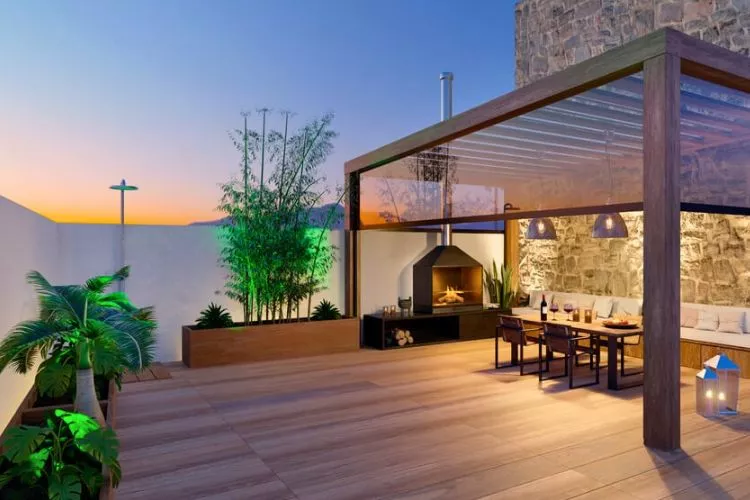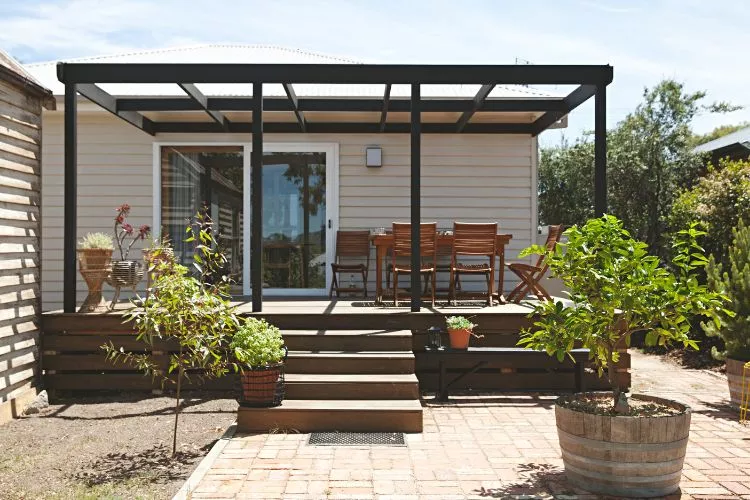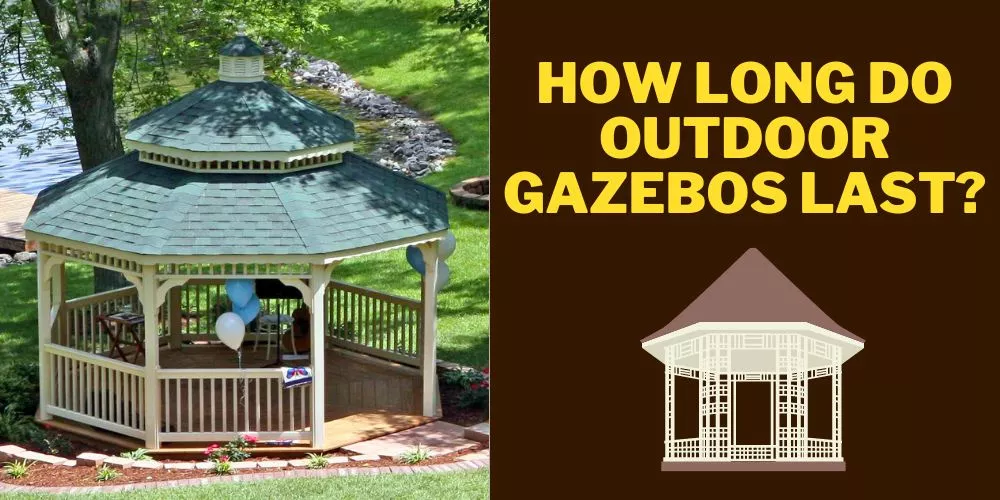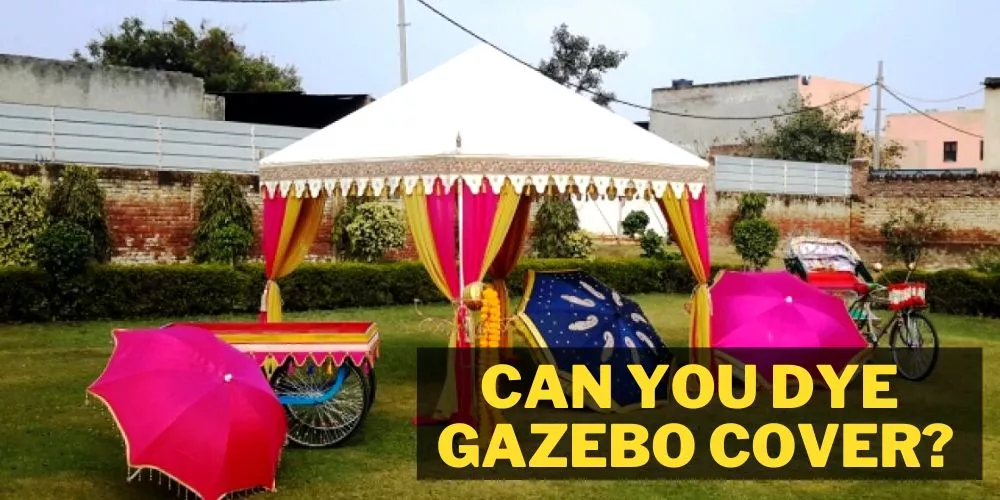Ah, the classic pergola! Traditionally, when one thinks of a pergola, images of an open-roofed, wooden framework come to mind. But like all things, pergolas too are evolving. Enter the emerging trend: solid roof pergolas.
Now, you might wonder, “Can a pergola have a solid roof and still retain its classic charm?” or, “Is this the solution to those unpredictable rain showers that ruin my outdoor gatherings?” If these questions resonate with your concerns, you’re in luck!

Can a pergola have a solid roof?
Certainly, a pergola can have a solid roof! Traditionally, pergolas were designed with open lattices, which created a beautiful interplay of light and shadow. However, modern design trends and evolving outdoor living needs have seen a shift.
Homeowners and designers are now gravitating towards pergolas with solid roofs, realizing their manifold advantages. A solid roof provides extended protection from weather elements—an unexpected summer downpour or the relentless midday sun. This means your outdoor space remains usable irrespective of the weather, enhancing its utility and versatility.
Moreover, while traditionalists may argue about the aesthetic compromises, the truth is that solid roofs open a world of design possibilities, from roofing materials to integrated skylights.
Furthermore, a solid roof doesn’t mean the loss of natural elements. Integrating green roofs, hanging plants, or translucent panels can bridge the gap between traditional and modern designs. So, in essence, a pergola can have a solid roof and redefine what we understand as the essence and functionality of a pergola in contemporary outdoor design.
Pros and Cons of a Traditional Open-Roof Pergola
While the traditional open-roof pergola has long been a beloved feature in gardens and patios worldwide, it has its own advantages and drawbacks. Before diving into the modern shift towards solid roofs, let’s explore the strengths and challenges associated with this classic design.
Pros:

Aesthetic appeal and natural ambiance
The quintessential open-roof pergola stands out as a structure and a piece of art. Its open design seamlessly integrates with nature, providing a timeless organic aesthetic.
Whether set against the backdrop of a lush garden or overlooking a serene pond, its lattice framework offers a harmonious blend of architecture and the outdoors, evoking feelings of relaxation and peace.
Good ventilation and sunlight
One of the primary benefits of an open-roof pergola is the constant flow of fresh air. Breezes can easily waft through without any barriers, creating a comfortable environment, especially during warmer months.
Furthermore, the open design ensures ample sunlight filters through. On a sunny day, this creates a mosaic of light and shadow on the ground, allowing you to sunbathe or read a book in the gentle embrace of filtered sunlight, without the intensity of direct exposure.
Versatility for plant growth
Traditional pergolas serve as an excellent support system for various climbing plants. From fragrant jasmine to ornate wisteria, these plants can weave through the open lattice, adding to the structure’s beauty.
Over time, the pergola becomes a living entity, as vines and creepers envelop it, often blossoming into flowers or bearing fruit. This augments the structure’s visual appeal and provides natural shade and a habitat for various birds and pollinators.
Cons:

Limited protection from weather elements
While the open design of a traditional pergola is undoubtedly its charm, it also exposes its Achilles’ heel. This design doesn’t offer complete protection from sudden rain showers, scorching sun, or snow.
A sudden downpour can dampen an outdoor lunch or gathering, and prolonged exposure to harsh sunlight can fade furniture, making it essential to consider additional shading or protective options.
Lack of privacy
An open-roof pergola might not be ideal for those seeking a secluded outdoor spot. Neighbors from higher vantage points or nearby buildings can easily look in. If you aim for a private retreat to meditate, read, or simply escape the world’s eyes, a traditional pergola might fall short without adding curtains, blinds, or climbing plants to shield the space.
Maintenance challenges
The beauty of a plant-laden pergola can sometimes come with its maintenance tasks. Climbing plants can become overgrown, especially when left unchecked, leading to potential structural strain.
Furthermore, an open-roof design may accumulate debris like fallen leaves, bird droppings, and the occasional twig, necessitating regular cleaning. And let’s not forget the wood itself. Depending on your region’s climate and the wood type, your pergola may need periodic treatments to prevent rot, insect damage, or weathering.
Advantages and Drawbacks of Solid Roof Pergola
As the lines between indoor and outdoor living spaces blur, the solid roof pergola emerges as a contemporary answer to evolving needs. But like every design choice, it comes with advantages and challenges.
Before diving headfirst into this modern architectural trend, weighing the benefits against the potential drawbacks is pivotal, ensuring you make an informed decision tailored to your unique outdoor living aspirations.
Advantages:

Enhanced weather protection
Gone are the days when a sudden shower could ruin your alfresco brunch. A solid roof pergola offers unparalleled protection against various weather elements.
Whether it’s rain, hail, or even snow in some regions, a solid roof ensures that your outdoor space remains as functional as indoors. This means more barbecues, garden reading sessions, and fewer runs to escape the unexpected rain!
Increased shade and comfort
The joy of a sunny day can quickly become discomfort with the relentless heat beating down. A solid roof pergola is a barrier against this direct heat, providing consistent shade throughout the day.
No more shifting your seating every few hours to dodge the sun or worrying about your outdoor furniture fading! Instead, imagine a cool, comfortable spot in your garden where the temperature feels just right, making every moment under your pergola an absolute delight.
Additional privacy
While the beauty of an open pergola lies in its inclusivity with nature, a solid roof offers a touch more seclusion. This design shields from prying eyes, especially in a densely populated area with overlooking buildings.
Whether sunbathing, practicing morning yoga, or having an intimate dinner, a solid roof pergola ensures that these moments remain private, turning your outdoor space into a sanctuary of solitude.
Drawbacks

Reduced natural light
A notable trade-off with solid roof pergolas is the potential reduction in natural light. While they excel in offering shade, they might inadvertently create a space that feels a tad darker than desired, especially on already overcast days.
If you’re someone who relishes in sun-drenched spaces or wants to harness the health benefits of direct sunlight, this could be a point of contention.
Ventilation strategies
Traditional open-roof pergolas naturally promote air circulation, ensuring a breezy outdoor setting. On the other hand, solid roofs can sometimes impede this airflow, potentially leading to a warmer, stuffier environment below, especially during peak summer months.
Thus, having a solid roof might necessitate additional ventilation strategies, such as integrating ceiling fans or designing with strategic gaps to promote airflow.
Design customization
While solid roofs offer a range of materials and styles, the very nature of being “solid” can sometimes limit design possibilities. Unlike lattice designs where climbing plants can weave their magic, or where playful patterns of sunlight can dance on the ground, a solid roof requires more forethought in integrating these elements.
Whether incorporating skylights, using translucent panels, or hanging greenery, achieving the same natural intimacy demands extra creativity and planning.
Design Options for Solid Roof Pergolas
Embarking on the journey of adding a solid roof pergola to your space is like flipping through an artist’s palette, with myriad colors and textures awaiting your selection. The design possibilities are vast, catering to minimalists seeking sleek modernity and those pining for rustic charm. Before diving deep into the materials and integrative options, let’s set the stage for what lies ahead in solid roof pergola designs.

Traditional Roofing Materials
When envisioning a solid roof pergola, the material choice is paramount for aesthetics, durability, and functionality. Traditionally, there have been some front-runners in the world of pergola roofing, each boasting its own set of merits. Let’s delve into these classic options that have stood the test of time.
Wood
The timeless charm of wood remains unrivaled. Offering a natural, organic feel, wooden roofs blend with garden surroundings, creating a cozy and warm ambiance. The longevity and maintenance needs can vary depending on the type of wood chosen – be it redwood, cedar, or pine.
While wood exudes a rustic elegance, it’s essential to ensure it’s treated to withstand external elements, warding off potential decay and insect damage.
Metal
Metal roofing is a top choice for those seeking a sleek, modern look. Beyond its contemporary appeal, metal roofs, whether made of aluminum, steel, or copper, are praised for their durability and ability to reflect sunlight, reducing heat absorption.
They’re also notably low maintenance and can withstand diverse weather conditions. However, it’s worth noting that they can be noisier during rain compared to other materials.
Polycarbonate panels
Polycarbonate panels might be your go-to if you aim for a balance between protection and natural light. These translucent panels allow filtered sunlight to pass through, shielding you from UV rays and rain.
Available in both clear and tinted versions, they offer flexibility in design while being lightweight and durable. A modern solution, polycarbonate panels bring the outdoors in without the usual drawbacks.
Integration with Outdoor Spaces
Crafting the perfect pergola goes beyond just the primary structure; it’s about how that structure mingles with the surrounding environment, enhancing your outdoor living experience. Integration elements add functionality, beauty, and a touch of personal flair. Let’s explore some of these features that can elevate your solid roof pergola into a harmonious outdoor haven.
Skylights or translucent panels
A brilliant solution to the potential dimness of a solid roof is integrating skylights or translucent panels. These additions ensure your pergola remains bathed in a soft, natural glow without compromising protection.
Whether you opt for small, decorative skylights or larger panels, you control the ambiance, making daytime gatherings under your pergola luminous.
Incorporating ceiling fans
Air circulation is crucial, especially under a solid structure. Ceiling fans are a functional and stylish solution. They not only provide a gentle breeze on stifling summer days but can also help deter pesky insects.
Depending on your design aesthetics, you can choose from rustic wooden fans, sleek metallic ones, or even those with integrated lights, blending utility with design.
Greenery and hanging plants
Nature’s touch within architectural spaces is rejuvenating. Even with a solid roof, there’s ample opportunity to infuse greenery. Hanging plants, ferns, spider plants, or cascading ivies, can create a lush canopy effect.
Vertical planters on pergola pillars or trailing vines along the edges can help retain the garden essence, making your pergola a verdant retreat.
Architectural Styles
Every pergola tells a story, echoing the design aspirations of its creator. While the functional elements are vital, the architectural style you choose gives your pergola its soul. It reflects your aesthetic preferences, making your outdoor space truly your own.
Let’s dive into two of the most sought-after styles, showcasing how vastly different yet equally captivating they can be.
Modern and sleek
The modern and sleek style resonates deeply for those who adore clean lines, minimalistic designs, and a touch of sophistication. This approach often features monochromatic color palettes, metallic or polished wood finishes, and an absence of excessive ornamentation.
The focus is on creating a streamlined look, where every element has a purpose and contributes to a harmonious whole. Think large glass panels, modular furniture, and perhaps a touch of abstract art to seal the deal.
Rustic and traditional
On the flip side, rustic and traditional designs beckon those who cherish a touch of nostalgia, the allure of natural materials, and a sense of timelessness. This style is all about wood in its rawest form, perhaps stone pillars, and design elements that evoke a bygone era.
It’s common to see ornate woodwork, wrought iron fixtures, and even a lantern. The goal is to create a cozy and inviting space, reminiscent of old-world charm yet functional for today’s needs.
Key Things to Consider When Building a Solid Roof Pergola
Embarking on the journey of crafting a solid roof pergola is undeniably exciting. It promises a transformed outdoor space, brimming with possibilities. However, like any architectural endeavor, it requires meticulous planning.
There are some crucial facets to contemplate before hammer meets nail, ensuring your pergola isn’t just visually pleasing, structurally sound, and enduring. Let’s touch on these pivotal considerations that lay the foundation for a successful pergola project.

Local regulations and permits
Starting any construction project on the right foot is crucial, and that begins with understanding local building codes and regulations. Depending on your locale, Pergolas, especially those with solid roofs, may be subject to specific requirements. Before breaking ground:
- Research Local Codes: Check with your city or county’s building department. They can provide information on height restrictions, distance from property lines, and other zoning concerns.
- Secure Necessary Permits: While it might seem like an added chore, obtaining the right permits ensures your project is legally sound. Plus, it can help avoid potential fines or having to undo your hard work later.
- Engage with Neighbors: Keeping neighbors informed can foster goodwill. They may have insights or concerns that you hadn’t considered.
Structural integrity and load-bearing capacity
The aesthetics of a pergola are just the tip of the iceberg. Below the surface, it’s the strength and sturdiness that count. With the addition of a solid roof, there’s added weight and stress on the pergola’s framework. Thus:
- Hire a Professional: Even if you’re a DIY enthusiast, consulting an architect or structural engineer can offer valuable insights. They can evaluate soil conditions, recommend appropriate foundation depths, and ensure robust design.
- Select Quality Materials: Your choice of wood, metal, or other materials should be based on their strength and longevity. Remember, they need to support the roof and endure environmental stressors.
- Plan for Varied Loads: Consider the additional weight of snow in winter or the force of strong winds. Your pergola should be built to withstand such variables without buckling or swaying.
Water runoff and drainage
While offering shelter and shade, a solid roof introduces the challenge of managing water runoff. An effective drainage system isn’t just about preventing puddles on your patio; it’s about safeguarding the longevity of your pergola and the surrounding environment. Steps to consider:
- Slope Design: Even a slight incline in your roof can guide water to designated runoff areas. This prevents pooling and potential water damage.
- Gutters and Downspouts: Integrate them seamlessly into your design. They channel water away, preventing soil erosion and potential damage to your home’s foundation.
- Surface Treatments: Think about porous pavements or well-placed garden beds to absorb runoff, turning a potential problem into an aesthetic and environmental solution.
Material selection for durability
The choice of materials for your pergola goes beyond aesthetics. It’s about finding a balance between beauty, durability, and maintenance. Here’s how to strike that balance:
- Research Material Lifespan: Whether it’s wood, metal, or synthetic materials, understand their longevity. Cedar, for instance, is rot-resistant while certain metals resist rust.
- Climate Considerations: Choose materials that resist mold and mildew in humid climates. In sun-soaked regions, UV-resistant finishes can prevent fading and degradation.
- Maintenance Factor: Some materials might look stunning initially but require frequent upkeep. Weigh the beauty against the effort and cost of regular maintenance.
Maintenance and Longevity of Solid Roof Pergolas
So, you’ve built that dreamy solid roof pergola, a testament to design flair and outdoor luxury. However, regular maintenance is non-negotiable to keep it standing tall and looking its best for years to come.

A pergola is not just about the now; it’s an investment in the future. To ensure it remains an ageless beauty, there are vital upkeep steps. Let’s dive into the practicalities of maintaining your pergola and ensuring its longevity.
Cleaning and debris removal
A clean pergola is aesthetically pleasing and instrumental in prolonging its lifespan. Regular cleaning ensures:
- Debris Check: Regularly clear off leaves, twigs, and other debris, especially after storms. Accumulated debris can retain moisture, becoming hotbeds for mold and mildew.
- Wash Down: A gentle hose down or a wipe with a damp cloth can prevent the build-up of dirt and dust. For more stubborn spots, a mild soap solution can work wonders.
- Seasonal Deep Cleans: Consider a more thorough cleaning once or twice a year. This is especially essential for pergolas near trees or areas with high pollen.
Inspecting for damage
Routine checks can help you spot minor issues before they snowball into major, costly repairs:
- Roof Inspection: After extreme weather events, check for any signs of wear, tear, or damage. Look out for loose panels, cracks, or any areas that may cause leaks.
- Structural Assessment: Ensure the pillars, beams, and joints are sturdy. Any sign of weakness or wobble should be addressed immediately.
- Fasteners Check: Examine screws, nails, and other fasteners. Over time, they might loosen or rust, compromising the structure’s integrity.
Preventing mold and mildew growth
Moist environments can be a breeding ground for mold and mildew, which not only mar your pergola’s beauty but can also damage its structure:
- Good Ventilation: Ensure the area around your pergola has adequate airflow. Consider the placement of surrounding plants and other structures.
- Regularly Dry Wet Areas: If your pergola gets wet due to rain or other reasons, dry it out as soon as possible, especially in shaded spots.
- Use Mold-resistant Sealants: When selecting paints or sealants for your pergola, choose those designed to combat mold and mildew growth.
Pro Tips
Solid roof pergolas are more than just a trend; they’re a testament to architectural evolution that combines function and aesthetics. However, just like any substantial home improvement project, making informed decisions is essential to get the most out of your investment. As someone who’s navigated the pergola world, I’ve got a few pearls of wisdom to share.

- Assess Before You Invest: Step back before diving headfirst into the solid roof pergola world. Think about how you typically use your outdoor space. Are you an entertainer, or is it more of a personal sanctuary? What’s the climate like in your area? Also, what’s the overarching aesthetic theme of your home? These reflections can significantly influence your design choices and functionality requirements.
- Light Matters: One of the common hesitations with solid roofs is the potential loss of natural light. But here’s the catch – it doesn’t have to be that way. Incorporating skylights or translucent panels can strike a balance, giving you the best of both worlds. You get the protection and still maintain a semblance of the open-roof feel.
- Material Wisdom: While choosing materials purely based on appearance might be tempting, it’s crucial to think long-term. Factors like your local climate and personal design preferences play a significant role. Some materials fare better in wetter climates, while others are perfect for areas with more sun.
- Don’t Skimp on Safety: I can’t stress this enough – consider getting professional input. Pergolas are significant structures, and ensuring they’re safely installed is paramount. A professional can guide you on the foundational needs, load-bearing capacities, and other structural intricacies.
- Maintenance Isn’t a Maybe, It’s a Must: As with all things, taking care of your solid roof pergola ensures it takes care of you for a long time. Regular maintenance checks, cleaning, and prompt damage repairs will keep it looking fresh and structurally sound.
Considering these tips will make your pergola journey smoother and ensure that the outcome is something you’ll cherish for years.
You may also like to know: How Much Wind Can A Pergola Withstand?
Frequently Asked Questions (FAQs)
Can a solid roof pergola be used in all climates?
Yes, solid roof pergolas are versatile and suitable for various climates, from sunny to rainy. Choose materials and designs based on specific climate challenges for best results.
Are there eco-friendly roofing options for solid roof pergolas?
Absolutely! Consider recycled metal, reclaimed wood, or sustainable materials like bamboo. Green roofs with vegetation are also an innovative, eco-friendly option.
Can I install lighting fixtures on a solid roof pergola?
Yes, you can. With proper wiring and fixture selection, lighting can seamlessly integrate, enhancing the pergola’s ambiance and usability at night.
What’s the cost difference between an open-roof and solid roof pergola?
Solid roof pergolas are more expensive due to added material and installation complexities. However, costs vary based on design, materials, and region. Always get multiple quotes for an accurate comparison.
Conclusion:
In conclusion, solid roof pergolas offer numerous benefits, from enhanced weather protection to increased privacy. While the allure of traditional open-roof designs remains undeniable, the choice largely hinges on personal preferences and functional needs.
If you’re contemplating this upgrade and wondering can a pergola have a solid roof? we encourage diving deeper into research, weighing all options, and tailoring the design to your unique space and lifestyle. We hope that this guide has been helpful. You can read about similar topics here on our website. Check back again soon for more.


